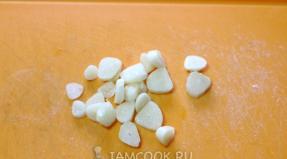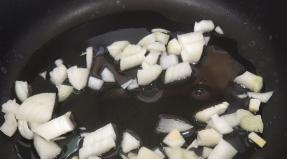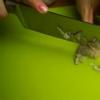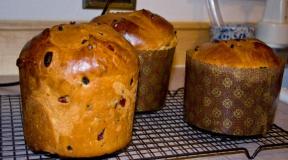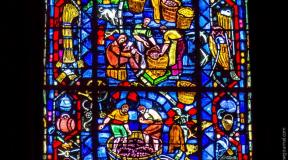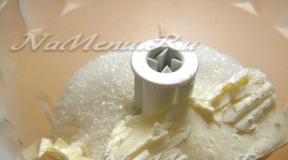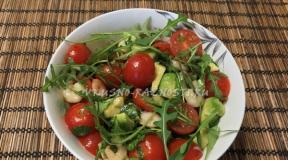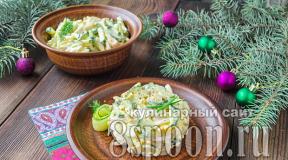What is better to cook from the eye muscle. Cutting alternative cuts
We talked about cutting cuts of American beef such as the upper part of the thigh cut (Sirloin Cap), flank (Flank Steak), sweetbreads (SweetBreads), thin diaphragm (Skirt steak), brisket (Brisket Flat Cut) and short ribs (Back ribs) . Here we end the story by introducing three more cuts.






Blade
We take a whole shoulder blade when ordering veal - the entire shoulder part of the calf with the bone removed. It is one of the cheapest cuts in veal and can be very successful if you know how to work with it. But it cannot be used to make schnitzels!
Firstly, such a shoulder blade can be baked. To do this, I coat it on top with a dry mixture based on mustard. Secondly, you can stew. To do this, I cut the shoulder blade into steaks, which I first fry (the temperature of the meat inside should be about 45 ° C), and then I cool and cut into portions weighing 350-370 g. When the order arrives, I simply warm them up.
The problem with shoulder steaks is that they produce a lot of waste because the shoulder tapers towards the edges. I cut off these ends and cut them into small pieces and use them in pasta sauce.
Upper part of the blade (Top Blade)
This is the second tenderest cut after the tenderloin.
I get a piece in a package. It has fat on the outside, and a membrane on the inside, which makes up 10-15% of the volume. The membrane must be removed. But the problem is not only this: in the middle there is another membrane, very rigid - it contains a lot of collagen, gelatin. It goes through the entire shoulder blade, and it also needs to be removed.
It actually disappears towards the far end, and you can make "feather" steaks from this end. They consist of meat on one side and the other, and in the middle there is a membrane that runs like a seam. But it is gelatin, and after cooking it becomes soft. For the preparation of such steaks, you can use about half of the shoulder blade - and then the membrane becomes very thick and rigid.
This half of the spatula can only be used by removing the membrane.
Then you can cook, for example, a steak Iron. The only thing is that the fibers in it will not go vertically to the grill surface like in other steaks: in the Iron, the fibers go horizontally to the grill, which is why this steak shrinks and rises a little when cooked. After cooking, he must be given a little rest.
From this part of the shoulder blade, you can make another dish - Roll. To do this, the steak needs to be divided into two parts and put the stuffing inside - I usually use spinach and mushrooms. I roll the steak, fry it in a pan and cook it. This is a great dish for the winter season!
Meat can also be used in a salad (eg Caesar). We cut it into small portions, 100-120 g per dish. These are some of our bestsellers - Utug steak and Caesar salad!
One piece of shoulder blade makes about six iron steaks, six or eight feather steaks, and the edges go to Caesar salad. Thus, the whole cut is used.
When preparing a shoulder blade, you need to be prepared for fairly large losses: after removing the membrane and core in the middle, 30-35% of the cut is lost. But since it is the second tenderest muscle, the cut is still profitable.
Due to the fact that this muscle is actively working, a lot of blood passes through it, which means that it has a lot of iron, it may seem that the steak has a liver flavor.
It is worth noting that the inner membrane may not be removed - if, for example, you do not make steaks, but bake the entire shoulder blade. In Germany and Holland, it is baked whole to a state of well down at a low temperature. But the maximum profit can be obtained by dividing the spatula into steaks and heating them on the grill.
Rump (Eye of Round)
This is the round muscle of the thigh, the eye muscle - one of the most tender cuts of meat you can get.
It's perfect for roast beef sandwiches. Due to the fact that the muscle is dense, it fits well on a sandwich. We also make schnitzel out of it - but we definitely beat it off!
In addition, the rump can be stewed. We cut it into portions of 280 g each and stew with vegetables in vegetable broth, then serving whole with the same vegetables.
The rump can be slowly smoked, putting a crust of pepper on it, and then thinly sliced - it becomes like basturma.
A good housewife can cook almost any dish, and bake any meat in the oven. Although some argue that pork is best for roasting, beef turns out to be a bit dry. This is not entirely true - you can bake any meat, and lamb ham, and small quails. The only difference is in the method of preparation.
So that beef with vegetables or pork does not turn out too dry, the meat must first be marinated and baked in a whole piece. It is worth choosing either a beef eye muscle or buttocks, for pork - a ham or neck. And, of course, do not forget about the freshness of the meat.
Now for the marinade. For this purpose, products such as soy sauce, mustard, adjika, celery root and parsley, garlic and herbs are well suited. It is important to consider that when heated, the taste and aroma of dry spices intensifies, so they need very little.
The meat must be washed in cold water and cut off thick films and veins. Then place the meat in the prepared marinade and leave for at least an hour. Pickling time can be up to 2 days, depending on the desired result. Store marinated meat in an airtight container: a container or pan with a tight-fitting lid, a plastic bag or cling film.
You can bake the meat in foil or without it, but then you will need to grease the meat with oil and pour over the juice that stands out so as not to get a dry piece.
By the way, meat can be baked not only in the oven. The recipes in the slow cooker are simple and varied, and the meat turns out to be surprisingly soft and fragrant.
Baking temperature - first 220'C, and after the formation of a golden crust - 160'C. The baking time depends on the size of the meat piece and ranges from 1 hour to 2.5 hours (for a piece weighing from 500 g to 3 kg).
1 /11
—1 —
Sirloin type steak
Fat:. 5.4 gr
Calories: 206
Saturated fat: 2 gr.—2—
eye muscle
Fat: 7 gr.
Calories: 276
Saturated fat: 2.4 gr.The eye muscle refers to the hip part of the carcass. Due to its round shape, it is similar to a filet mignon, but it is much tougher and much less juicy. Therefore, the eye muscle should be cooked prime rib and cut as thin as possible.
—4 —
Top sirloin
Fat:. 10.6 gr
Calories: 316
Saturated fat: 4 gr.The steak is cut from the central loin.It is quite acceptable to cook it like a tenderloin: quickly and at high temperatures.The sirloin top lacks marbling, so the ideal degree of doneness for such a steak is medium.
—5—
Bottom round
Fat: 11 gr.
Calories: 300
Saturated fat: 3.8 gr.Bottom round - a steak from the hip part - does not have the highest degree of marbling, so it is better to stew it. The juiciness of the fillet steak will be guaranteed if you do not cook it above medium rare and add a little spice.
—6—
Sirloin flap
Fat:. 12 gr
Calories: 240
Saturated fat: 3.8 gr.The flap steak is cut from the bottom of the thigh cut.It has a rough structure, which means that one cannot do without marinade and spices.If the steak is stewed, it breaks up into tender, juicy pieces.Such meat is suitable for medium or medium roast - then the softness of the flap steak is ensured.
—7—
filet mignon
Fat:. 16 gr
Calories: 348
Saturated fat: 6 gr.So, filet mignon claims to be the most tender meat simply because it is cut from that part of the carcass, the muscles of which are less involved in the life of the animal.Of all the premium steaks, it is the filet mignon that is famous for having the lowest fat content.The cut is not capricious either in terms of seasoning or cooking, but salt, pepper and roasting on both sides over high heat are considered the ideal option.
—8 —
Porterhouse / T-bon
Fat:. 16.4 gr
Calories: 346
Saturated fat: 6.6 gr.It is no coincidence that Porterhouse can be found in the best restaurants in the world.The peculiarity of this cut is that it actually consists of two types of meat separated by a T-shaped bone.On the one hand, it is a fillet, and on the other, a thin edge of the tenderloin (New York).Cook the meat over high heat until golden brown.The recommended degree is medium or medium rare.
—9 —
Skert steak
Fat:. 17.2 gr
Calories: 348
Saturated fat: 6.6 gr.The skint steak is generously pierced with marble layers of fat, thanks to which it has a delicate texture and deep taste.. At the same time, the cut is so thin that it is incompatible with low temperatures.. You need to cook it only on high heat, AT maximum temperatureALSO, the skint steak must be marinated - this way it will be juicier, and its fibers hold the marinade perfectly.
Text author Nadezhda Firsova
I'll tell you a little about the parts of the carcass and the methods of preparing a particular cut. In preparing this material, I relied on the recommendations of the Meat and Livestock Corporation of Australia. Firstly, they take into account modern gastronomic trends, and secondly, meat from beef cattle (Australian, American, or, at worst, our Angus), in my opinion, is much more interesting in terms of culinary potential. Australians are one of the most advanced people in the meat field, so they have the floor. I translated the materials and the name of the cuts, so if someone notices inaccuracies, I will gladly accept corrections and comments.
So, for meat, the following types of cooking are offered:
- grill (on live fire, in a frying pan),
- baking,
- stir fry (the product is cut into strips 10 mm wide and 75 mm long, quickly fried, for example, on a wok),
- shabu-shabu (the product is cut into slices 2 mm thick, cooked in hot broth or oil),
- braising (or, as the Australians call it, caserol),
- salting.
There are a couple more exotic ways, but I would omit them. But you can add carpaccio, tartare. I would also like to note that all of the above methods in relation to cuts are recommended, taking into account the fact that aged meat is used, which undoubtedly has a better organoleptic quality compared to unaged.
Carcass cutting scheme. Here I present an Australian cutting scheme. What makes it more convenient, in my opinion: the international terminology for designating cuts is already actively used in our everyday life, so it’s good to have both the Russian and English versions of the name before our eyes. Also, not only cuts are given here, but also their components (for large cuts), which is also useful, because in one cut there can be muscles with different organoleptic characteristics. I will also be writing mainly about boneless cuts.
Rump (ramp, rump)- This is a large cut from the back quarter of the carcass. Beef ramp weighs 6-8 kg, and it is unlikely that you will shoot it in the store with a whole cut, but you still need to say about it. The ramp is divided into several large muscles. In general, the ramp refers to the so-called. alternative cuts – i.e. this is not premium meat, however, with proper cutting, you can even get good quality steak pieces.
Eye of rump side and eye of rump center- two oblong muscles (side is longer), located approximately in the center of the ramp. It is similar in structure to a tenderloin - you can even make a kind of filet mignon, only cut not very high steaks. Suitable for all types of grill, for baking, for stewing, stir-fry and shabu-shabu. You can also find the use of this cut for carpaccio.
Rump cap- so-called. "cover" ramp. On the cut, if the surface fat is not completely cleaned, it resembles a striploin - the same thickness of meat and a strip of fat. You can grill, bake, and also cook using the stir-fry method (it is advisable to clean the fat).
Rump flap- a small muscle that "closes" the Eye of rump. One ramp yields two rump flap steaks. What is typical for him is a steak with thick longitudinal fibers. It is recommended to cook it using the stir-fry method, but I believe that it can also be used for grilling, just pre-marinate and cook to medium.
Tritip- "tail" ramp. Baked, stewed and cooked using the stir-fry method.
Tenderloin (tenderloin)- the most tender meat in beef carcass. so-called. A "lazy" muscle that is not involved in motor activity. The most expensive cut, and one of the most delicious. In a good, seasoned tenderloin, the fibers are so soft and tender that the cut can even be pierced with a finger. You need to cook the tenderloin delicately, without overdrying it. If you are not dealing with meat of increased marbling, then your tenderloin will be very lean, therefore, cook it in roasts from re to medium so that it retains juiciness and softness. The tenderloin is divided into head, tail and trunk. The head is suitable for both grilling and stir-frying, but one of the best uses for the head is beef stroganoff! The entire trunk of the tenderloin is used for dishes such as roast beef, chateaubriand, beef wellington, etc. The trunk is used to make filet mignon steaks, medallions, grilled, in the oven, make shabu-shabu and stir fry. And, of course, carpaccio and tartare! The tail of the tenderloin can be used for grilling, baking and stir frying. You can also make a tagliata or a tournedo.
Striplon (striploin, thin edge)- a cut of their lumbar part of the carcass (10-13 ribs). One of the premium cuts. It has a pronounced meat taste, low-fat (there is a “cap” of fat, but it can be cut off). The most common use is steak! The recommended roasting is medium-re. You can also bake, for example, in the manner of roast beef. You can also make shabu shabu and stir fry.
Short-loin (short, lumbar cut on the bone)- this is a striploin and a tenderloin located on a T-shaped bone. Shortloin is such a large cut, weighing 6-8 kg, that is sawn into steaks - clubsteak (striploin on the bone), T-bone (striploin and tenderloin trunk) and Porterhouse (striploin and tenderloin head). It turns out that two types of meat are combined in one steak, and the bone gives the dish an additional flavor. Grilling, baking, stir-frying and shabu-shabu are also shown (which, in my opinion, is perverted - grilling and that's it!).
Knuckle (side leg)- large muscles, a lot of connective tissue and tendons. In general, baking, stewing and stir-frying are recommended.
Topside (inner part of the thigh cut)- there is not much connective tissue, the fibers are large. Also stewing, baking, stir-frying and shabu-shabu.
Outside (outer part of the hip cut)- contains both the outer part of the hip cut itself, and the eye muscle Eye round (semitendinosus muscle of the thigh). The outer part is used for shabu-shabu, stewing, stir-frying and salting. The eye muscle can be baked, salted, stewed, grilled (medallions), and also cooked using the stir-fry method.
Ribeye (ribeye, thick edge)- one of the most famous and delicious cuts. The name ribeye itself comes from two English words rib-eye, i.e. rib and eye. The rib is where the cut comes from, and the eye is the cross-sectional shape that ribeye steaks also inherit. Due to the presence of internal fatty layers, the ribeye remains very tender and juicy. The best cooking method is grilled steaks, which can be baked or stir-fried.
Read also...
- Cake "Smetannik" with custard: the easiest homemade inexpensive recipe Cake with sour cream with poppy nuts recipe
- Preservation of cucumbers for the winter - classic cooking recipes How to preserve cucumbers
- How to cook a honey ginger cake according to the classic step-by-step recipe Recipe for ginger honey cake at home
- Salads from canned fish, tasty and fast
